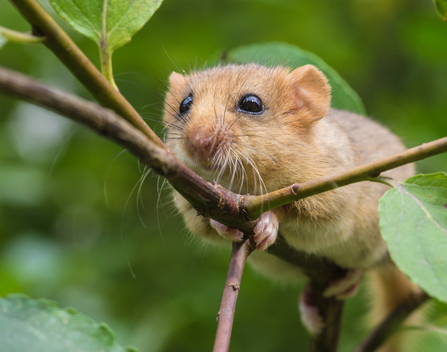
Dormouse - Adobestock

Dormouse - Adobestock
In Britain, dormice – known for their endearing appearance with soft caramel fur, furry tail and big black eyes – are threatened and are considered to be vulnerable to extinction. In fact, hazel dormice are already extinct from 17 counties in England. The areas where they are still known to exist are almost all entirely south of a line between Shropshire and Suffolk.
The State of Britain’s Dormice 2019 report underlines the importance of providing the right habitat for dormice, and maintaining such habitats via correct woodland management practices, is the key to bringing this endangered species back from the brink.
Ian White, Dormouse & Training Officer at PTES, explains: “The decline in dormouse numbers is due to the loss and fragmentation of their natural woodland and hedgerow habitats, as well as climate change. In particular, it’s the loss of habitat quality that’s of real concern. Sympathetic woodland management is essential for the recovery of dormice. Whether woodlands are managed for timber or public access, shrubby areas should be created beneath the tree canopy. These provide dormice, and many other species with areas to nest and feed in while also being able to access the mature trees. It is this variety of woodland habitats required to help dormice survive.”
Hazel dormice are arboreal mammals who prefer structurally diverse habitats – they use tree holes to nest in, dense woodland understory to raise their young and feed in, and hedgerows and bramble banks to disperse through. Critically, the way in which woodlands are managed has changed – with traditional management practices such as coppicing, glade creation and small-scale tree felling (which once created mosaic habits) becoming less common, and as a result many of the woodlands we see today simply aren’t suitable for dormice. These factors, combined with unseasonable or extreme weather (which can affect survival over the winter and impact on their ability to raise young), can be detrimental to dormice survival.
But, despite this, there are some areas where dormice numbers are increasing. At 96 of 336 sites (29%) analysed for this report, populations were ‘stable’ or ‘increasing’. Also, at 28 of these sites (8% of the total) the average annual increase was 5% or more per year. But, elsewhere, there is still lots of work to do.
Simone Bullion, Suffolk Wildlife Trust Conservation Manager says, “The latest report by PTES on the State of Britain’s Dormice highlights that reduction in habitat quality due to lack of woodland management is one of the factors causing the significant decline in numbers. At the Trust’s own ancient woodland reserve at Bradfield Woods, the historic practice of coppicing in patches each winter creates a superb mosaic of uneven age structure across the wood. Where management has recently taken place, light falls onto the woodland floor with accompanying displays of wild flowers and associated insects, including scarce butterflies. In addition, as the shrub layer regrows it becomes perfect for dormice, with plenty of food and arboreal pathways and this helps them to thrive here. Consequently, if we get it right for dormice, then we are getting it right for the woodland community as a whole.”
Ian concludes: “Although the State of Britain’s 2019 report shows a severe decline has taken place over the last 18 years, the good news is that in some areas dormice are doing well. We can help bring this species back if we alter the way we manage our landscape. By providing enough of the right habitat, which is well-connected and managed correctly, dormice, as well as a huge amount of other wildlife, can thrive once again across the country.”
To read the full report, and to find out more about PTES’ ongoing dormouse conservation work please visit: www.ptes.org/dormice